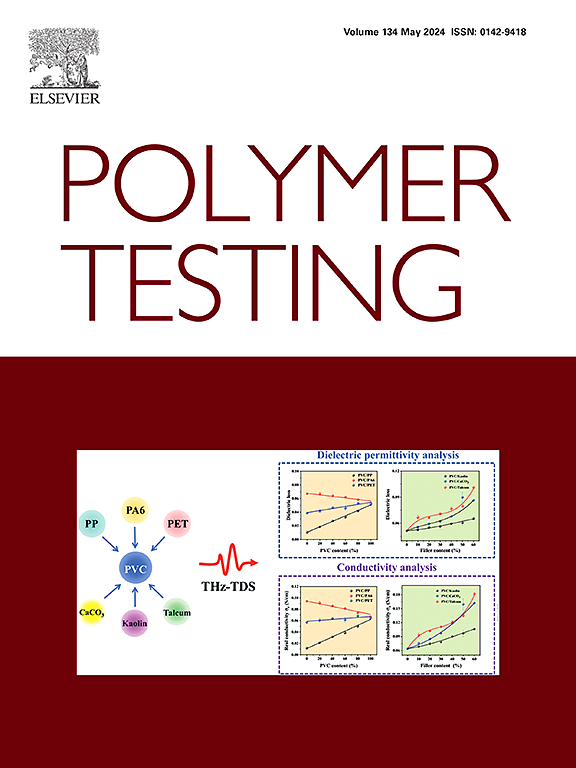Mechanical and electrical properties of a polymer electrolyte based on zinc oxide for enhancement of Li-ion battery performance
IF 5
2区 材料科学
Q1 MATERIALS SCIENCE, CHARACTERIZATION & TESTING
引用次数: 0
Abstract
This work was carried out to synthesize and apply mesoporous 3-mercaptopropyl pyridine-ZnO nanorods (MPP-ZnO NRs) as additives in a cross-linked composite gel polymer electrolyte for enhancing the performance of lithium-ion batteries. The MPP-ZnO NRs were synthesized using a sol-gel method and functionalized with MPP. The electrospun fibrous polyacrylonitrile (PAN) membrane was coated with ZnO nanorods, forming a stable and robust composite electrolyte. Results of mechanical tests indicated that compared to control membranes (without ZnO NRs), the MPP-ZnO-containing membranes showed significant enhancements, likely an increase in tensile strength (∼1.5-fold), an enhancement in adhesion strength (∼4-fold), and an increase in shear stress (∼3-fold). Electrochemical performance was evaluated using charge-discharge cycling and AC impedance spectroscopy tests. Findings demonstrated that utilizing cross-linked gel-polymer electrolytes with MPP-ZnO NRs showed lower charge transfer resistance and superior cycling stability, maintaining 89.0 % capacity retention after 200 cycles at 0.5C, with an initial discharge capacity of 179.9 mAh/g and 160.1 mAh/g after 200 cycles. Moreover, these cells showed remarkable capacity recovery, with an18 % higher capacity at 5.0C compared to non-porous counterparts and delivering discharge capacity of 139.8 mAh/g at 5.0C. Results showed good high-rate performance due to improved thermal stability and HF scavenging ability of the mesoporous MPP-ZnO NR-based electrolyte. These results indicate the potential of mesoporous MPP-ZnO NRs in advancing the performance and stability of lithium-ion batteries, making them as low-cost candidates for future energy storage applications.
用于提高锂离子电池性能的氧化锌聚合物电解质的机械和电学性能
本文研究了介孔3-巯基丙基吡啶- zno纳米棒(MPP-ZnO NRs)作为交联复合凝胶聚合物电解质添加剂的合成和应用,以提高锂离子电池的性能。采用溶胶-凝胶法制备了MPP- zno纳米粒子,并用MPP进行了功能化。用ZnO纳米棒包覆电纺丝纤维聚丙烯腈(PAN)膜,形成稳定、坚固的复合电解质。力学测试结果表明,与对照膜(不含ZnO NRs)相比,含有mpp -ZnO的膜表现出显著的增强,可能增加抗拉强度(~ 1.5倍),增强粘附强度(~ 4倍),增加剪切应力(~ 3倍)。通过充放电循环和交流阻抗谱测试来评价电化学性能。研究结果表明,使用交联凝胶聚合物电解质与MPP-ZnO NRs具有较低的电荷转移电阻和优异的循环稳定性,在0.5C下循环200次后保持89.9%的容量保持率,200次循环后的初始放电容量为179.9 mAh/g, 160.1 mAh/g。此外,这些电池表现出显著的容量恢复能力,在5.0℃下的容量比无孔电池高18%,在5.0℃下的放电容量为139.8 mAh/g。结果表明,介孔MPP-ZnO nr基电解质具有良好的热稳定性和清除HF的能力。这些结果表明介孔MPP-ZnO NRs在提高锂离子电池性能和稳定性方面的潜力,使其成为未来储能应用的低成本候选材料。
本文章由计算机程序翻译,如有差异,请以英文原文为准。
求助全文
约1分钟内获得全文
求助全文
来源期刊

Polymer Testing
工程技术-材料科学:表征与测试
CiteScore
10.70
自引率
5.90%
发文量
328
审稿时长
44 days
期刊介绍:
Polymer Testing focuses on the testing, analysis and characterization of polymer materials, including both synthetic and natural or biobased polymers. Novel testing methods and the testing of novel polymeric materials in bulk, solution and dispersion is covered. In addition, we welcome the submission of the testing of polymeric materials for a wide range of applications and industrial products as well as nanoscale characterization.
The scope includes but is not limited to the following main topics:
Novel testing methods and Chemical analysis
• mechanical, thermal, electrical, chemical, imaging, spectroscopy, scattering and rheology
Physical properties and behaviour of novel polymer systems
• nanoscale properties, morphology, transport properties
Degradation and recycling of polymeric materials when combined with novel testing or characterization methods
• degradation, biodegradation, ageing and fire retardancy
Modelling and Simulation work will be only considered when it is linked to new or previously published experimental results.
 求助内容:
求助内容: 应助结果提醒方式:
应助结果提醒方式:


